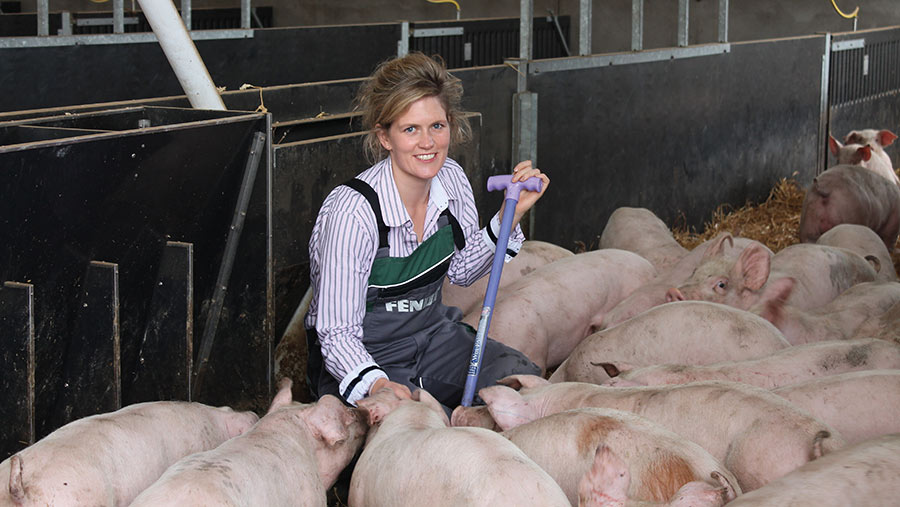How a pig bed and breakfast has added value to family farm
 © Rebecca Gladwin
© Rebecca Gladwin Rebecca Gladwin’s family is one of an increasing number adding a “bed and breakfast” pig finishing enterprise to their business.
It has minimal risk, improves cashflow with regular payments to supplement farm incomes or, as in this case, can provide additional income for family members joining the business.
The pig building was initially built when Miss Gladwin’s brother returned to the farm. Then, after a couple of years, he was needed full-time on arable operations.
See also: How to set up a pig bed-and-breakfast business
So, Miss Gladwin left her non-farming job and took on the management of the pigs, having already spent time helping on the unit.
The Gladwins have a contract with an integrated pig production and pork processing company, BQP, which produces and supplies the newly weaned piglets, fieldperson, veterinary care, feed and logistics.
Miss Gladwin and her family provide the building, labour, straw and water through to finished weight.
At finishing, pigs are selected for processing by eye.
Pig B&B costs
A turnkey build costs around £265,000 for 1,000 pigs, though total set-up costs will vary from farm to farm.
Expected annual turnover for a new build would be about £42,000, depending on the specifics of the contract, with a profit of about 50%.
The contract offers bonus payments for selecting pigs within the range and for achieving a target level of feed conversion. Each batch is on farm for abbout 20 weeks.
The pigs’ health, welfare and comfort are Miss Gladwin’s priorities and the basis for achieving good performance.
About the building
The light, airy, purpose-built pig building is naturally ventilated. It is divided into 21 pens of 50 pigs, with a straw-bedded area down the centre and scrape-through muck passages on either side.
Pigs are encouraged into the right habits from the start, through the daily routine of cleaning out, helping them to clearly differentiate between the warm, clean lying area and the dunging passage.
Pigs are given clean straw every day, with pens cleaned out completely if needed. Putting in this effort early on pays dividends later, says Miss Gladwin.
Providing the right type and quantity of bedding is key. Barley straw is used for bedding to begin with as it is soft and absorbent, with wheat straw used later on. Rape straw is occasionally added for variety and enrichment.
The building is on an open site so air movement is good. Automatically controlled Galebreaker curtains open and close depending on the weather conditions, with one on each side of the building.
There is a weather station on each side, monitoring wind speed and rain, plus a thermometer inside, and each curtain can be raised or lowered independently.
Only half of each pen is used while pigs are small and a sheet creates a temporary cover over the lying area to keep them warm, typically for the first two to three weeks.
The cover sheet, curtains and bedding are managed in a co-ordinated way and adjusted depending on the weather, age and needs of the pigs.
“For example, on a hot day when pigs are small, you might opt to put in less straw to keep piglets cool, rather than lower the curtains, which could cause unwanted draughts,” says Miss Gladwin.
Management
Piglets are split sexed and vaccinated soon after arrival, with boars going at one end of the building and gilts at the other, with a pen of smaller pigs in the middle, which helps keep them warm if they arrive in the winter months.
Pelleted feed is delivered via an automatic auger system with 10 feeder spaces in each pen (two hoppers with five spaces each). This is double the recommended number of spaces per pig.
They added the second hopper after two or three batches to improve feed cleanliness and efficiency, by reducing the risk of competition for feed spaces.
There are four different diets: creep, weaner plus, grower and finisher.
Milk-based powder is added to the bottom of the hopper with the creep ration to help piglets take to the feed more easily.
Pigs in the smalls pen are also given a gruel made with the weaner diet, milk powder and water, to ease their transition to pelleted feed.
Clean, fresh water is paramount, so any straw or feed is cleaned out of the water troughs twice daily.
In each pen there is a water trough, plus four nipple drinkers (two on each gate), providing water facilities beyond the recommended RSPCA assurance requirements.
Health
Treatments for any health issues are either administered individually or via the water using a select doser.
The doser measures daily water intake, which ensures the amount of additive required can be calculated accurately.
Measuring daily water intake is also a useful management tool for pre-empting any health challenges, if intake starts to deviate from the expected pattern, says Miss Gladwin.
It is an all-in, all-out system, with the building, equipment and water system fully cleaned and disinfected in between batches to help minimise disease challenge.
Benefits to the wider business
They also exchange muck for straw between their pig and arable enterprises.
Pig manure is a valuable commodity to arable farmers, with a 1,000-pig straw-based finisher unit like this producing, on average, 700t of manure each year.
The manure contains nitrogen, phosphorous and potash, reducing the need for bought-in fertiliser, improving soil structure and increasing water holding capacity, among other benefits.

